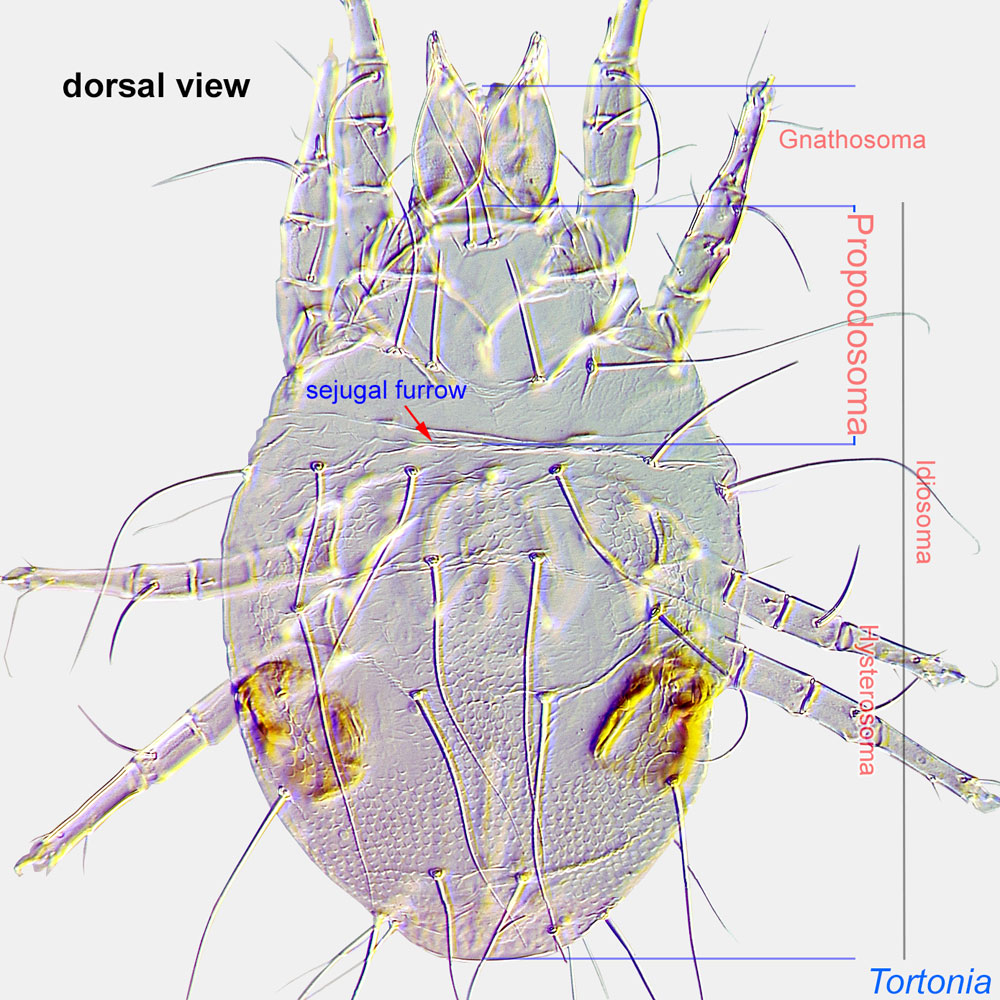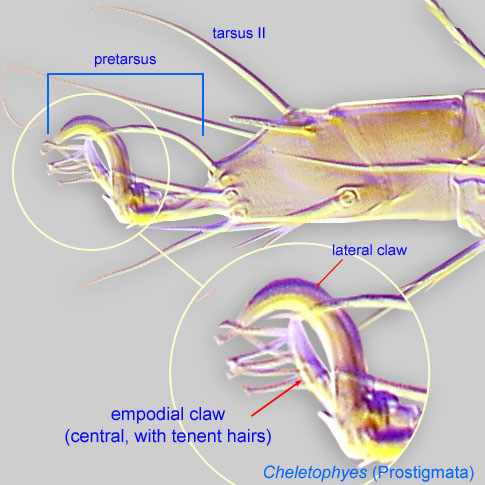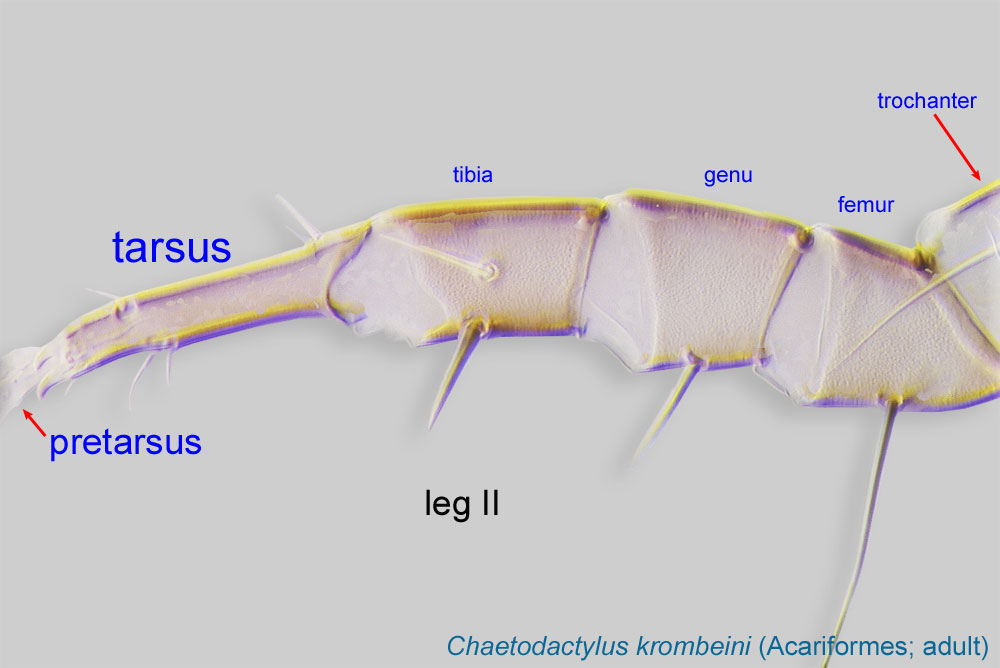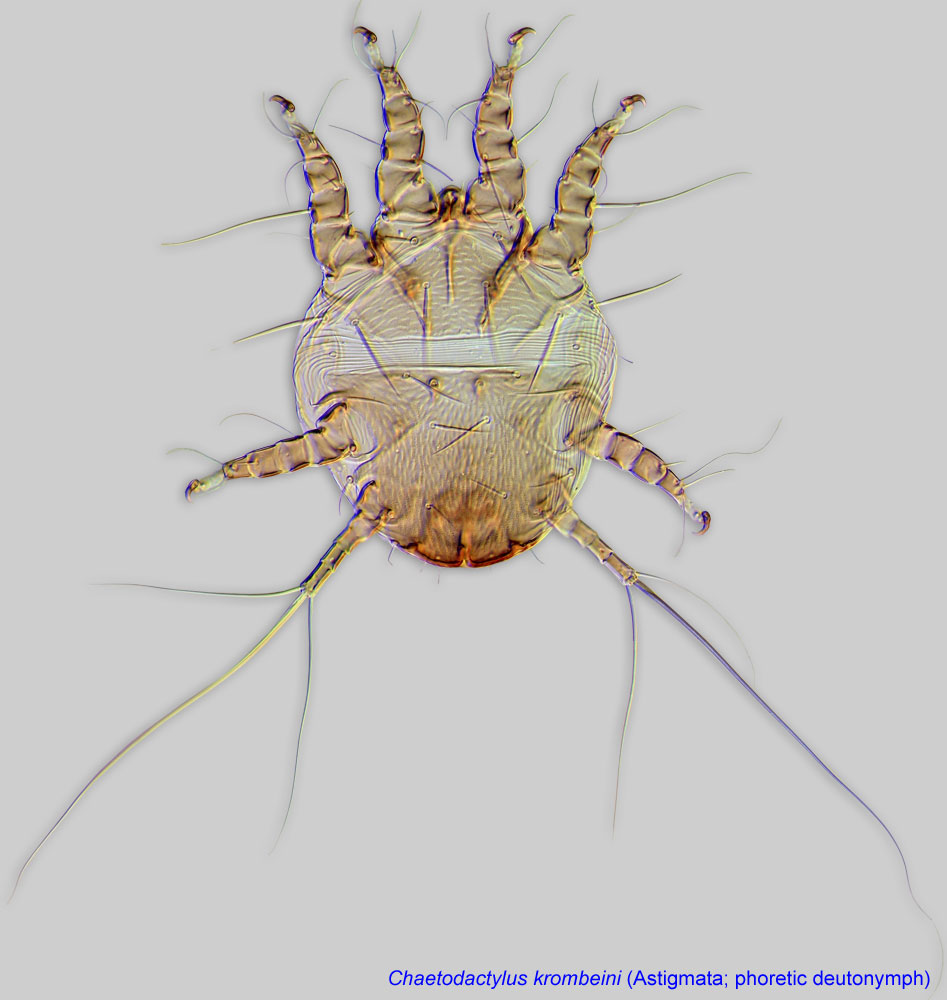probably neutral; generally prefers feeding on dead bees
Aeroglyphus Zachvatkin, 1941Zachvatkin, 1941:
Zachvatkin, A. A. 1941. Tiroglifoidnue kleshchi Tyroglyphoidea [=Tyroglyphoid mites Tyroglyphoidea]. In Fauna SSSR: Paukoobraznuye, ed. S. A. Zernov, 475. Moscow-Leningrad: Akademiya Nauk SSSR (translated to English in a separate publication).
Superorder Acariformes » Order Sarcoptiformes » Suborder Oribatida » Infraorder Desmonomata » Hyporder Astigmata » Family Aeroglyphidae » Genus Aeroglyphus
Glycyphagus peregrinans Berlese, 1892.
Adult: Prodorsumprodorsum:
Dorsal surface of propodosoma.
 with external vertical setae ve present (Fig. 3). Ventral subcapitulumsubcapitulum:
with external vertical setae ve present (Fig. 3). Ventral subcapitulumsubcapitulum:
Ventral faces of the fused palpcoxae.
without external ridges (fig. 4). Opisthosomaopisthosoma:
Body division posterior to legs IV; usually there is no distinct boundary delimiting this part of idiosoma.
with a row of small, closely spaced microtrichiae (small hair- or tooth-like processes) extending between the bases of most lateral body setae (Fig 5). Cuticle sometimes with larger irregular protuberances. Most dorsal setae, including c1, elongate and heavily barbed (Fig. 5). Pretarsal ambulacraambulacrum:
The claws and empodium of the apotele or pretarsus.
short, relatively simplesimple:
Of claws or setae; not modified or not bi- or trifurcate at tip.
(Fig. 12). Empodial clawsEmpodial claw:
Claw-like, membranous, or pad-like structure of setal origin. Present only on the pretarsus in Acariformes. In Astigmata, it is the only claw on the pretarsus and often referred to simply as the claw. In the remaining Acariformes, may be accomanied by two lateral claws. Also known as empodium, pretarsal empodium, or central claw.
 present, claw-like, simplesimple:
present, claw-like, simplesimple:
Of claws or setae; not modified or not bi- or trifurcate at tip.
(Fig. 12). Anus positioned near posterior margin of body (Fig. 7). TarsiTarsus:
Terminal segment (also known as podomere or palpomere) of legs or palps. In Parasitoformes it can be subdivided into telotarsus and basitarsus.
 III-IV without an elongate, scale-like basal seta (Fig. 2). Male without a sclerotized plate posterior to aedeagusaedeagus:
III-IV without an elongate, scale-like basal seta (Fig. 2). Male without a sclerotized plate posterior to aedeagusaedeagus:
An external organ of a male arthropod that is specialized to deliver sperm during copulation.
(Fig. 11). Setae ps3 in soft cuticle (Fig. 11).
The two known species, Aeroglyphus peregrinans and Aeroglyphus robustus, can be identified using redescriptions in Cooreman, 1959Cooreman, 1959:
Cooreman, J. 1959. Note sur le genre Aeroglyphus Zachvatkine,1941(Acaridiae, Glycyphagidae). Bulletin de l'Institut Royal des Sciences Naturelles de Belgique . 35 : 1-19..
Aeroglyphus robustus: Nearctic region (common), Palaearctic; Aeroglyphus peregrinans: SE Palaearctic: Europe and North Africa. An undescribed species has been collected from an Apis mellifera colony in South Africa (personal observation).
Phoretic phoretic:
Pertaining to phoresy; using another organism (i.e., a host) for dispersal to new habitats. Phoresy can be distinguished from parasitism because feeding typically does not occur during phoresy.
feeding stages of Aeroglyphus peregrinans have been found on large carpenter bees (Xylocopa) (most frequently), bumble bee Bombus lapidarius, and European honey bee Apis mellifera. Colonies of both Aeroglyphus peregrinans and Aeroglyphus robustus have been found in nests of the European honey bee, Apis mellifera.
facultative facultative:
can complete entire life cycle without bees or their close relative, wasps
(Aeroglyphus robustus) or permanentpermanent:
associated exclusively with bees or their close relative, wasps; cannot live without these hosts
(Aeroglyphus peregrinans)
Aeroglyphus robustus, generalist
 are absent. Feeding stages disperse by active movements or on host; phoresyphoresy:
are absent. Feeding stages disperse by active movements or on host; phoresyphoresy:Aeroglyphus peregrinans, bee-specialist
 are absent. Feeding stages disperse on large carpenter bees (most frequently) (Fig. 13), bumble bees, or honey bees.
are absent. Feeding stages disperse on large carpenter bees (most frequently) (Fig. 13), bumble bees, or honey bees.This genus contains two species that differ in habitat. Aeroglyphus robustus is considered a pest of stored grain, though it is probably a habitat generalist, preferring dry materials. It occurs in stored wheat, oats, and barley, stored grain, soybean, hay, nests of birds, beeswax culture of moth Galleria mellonella, on dead insects, and in beehives (of Apis mellifera) inside queen cells containing a dead queen (Delfinado-Baker and Baker, 1982aDelfinado-Baker and Baker, 1982a:
Delfinado-Baker, M. amp; E. W. Baker. 1982a. A new record for Aeroglyphus robustus in beehive. American Bee Journal . 122 : 110-110.).
In contrast, Aeroglyphus peregrinans is a bee specialist and has never been found in other habitats. It disperses as feeding stages on large carpenter bees, bumble bees, and honey bees and probably lives in nests of these hosts (documented only for the honey bee Apis mellifera (Grobov, 1978Grobov, 1978:
Grobov, O. F. 1978. Kleshchi medonosnoy pchely ( Apis mellifera L.): ikh znachenie i osnovnue printsypy bor'by s kleschchevymi porazheniyami [=Mites of the honeybee ( Apis mellifera L.): their significance and main principles of control of diseases caused by mites]. Doctor of Sciences (Habilitation) Thesis. 536. Moscow: All-Union Institute of Experimental Veterinary, All-Union Academy of Agricultural Sciences.)). A few literature records suggest that in beehives, both mite species prefer feeding on dead bees (Delfinado-Baker and Baker, 1982aDelfinado-Baker and Baker, 1982a:
Delfinado-Baker, M. amp; E. W. Baker. 1982a. A new record for Aeroglyphus robustus in beehive. American Bee Journal . 122 : 110-110.; Grobov, 1978Grobov, 1978:
Grobov, O. F. 1978. Kleshchi medonosnoy pchely ( Apis mellifera L.): ikh znachenie i osnovnue printsypy bor'by s kleschchevymi porazheniyami [=Mites of the honeybee ( Apis mellifera L.): their significance and main principles of control of diseases caused by mites]. Doctor of Sciences (Habilitation) Thesis. 536. Moscow: All-Union Institute of Experimental Veterinary, All-Union Academy of Agricultural Sciences.), but the cause of death is unknown for these bees. Early authors (Blattný, 1924) suggested that Aeroglyphus peregrinans (as well as species of Glycyphagus) can switch from being saprophagoussaprophagous:
Feeding on dead or decaying organic matter.
on dead bees to parasitic and, thus, irritate bees.